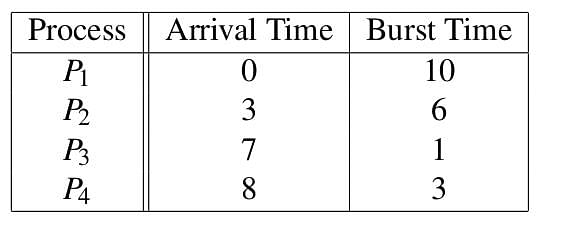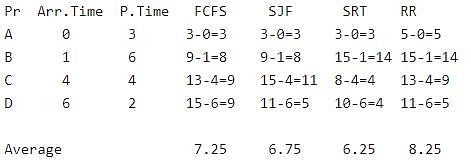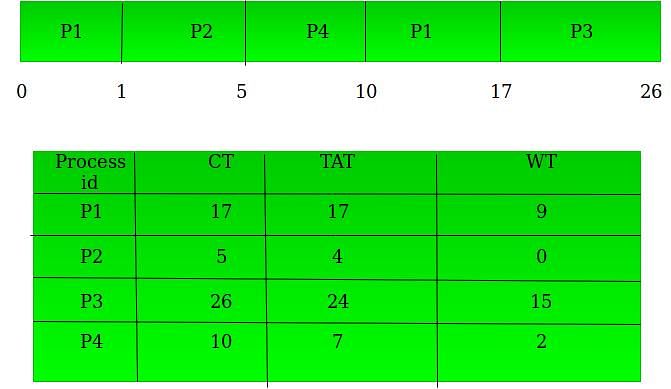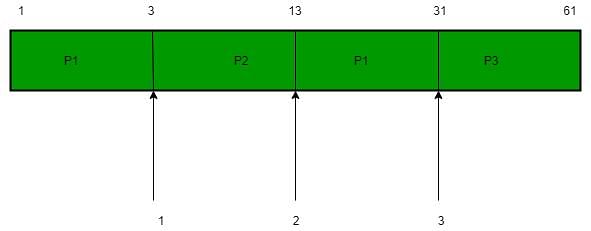Test: CPU & I/O Scheduling- 2 - Computer Science Engineering (CSE) MCQ
20 Questions MCQ Test - Test: CPU & I/O Scheduling- 2
For the processes listed in the following table, which of the following scheduling schemes will give the lowest average turnaround time?
Process Arrival Time Processing Time
A 0 3
B 1 6
C 4 4
D 6 2
A 0 3
B 1 6
C 4 4
D 6 2
Which of the following is FALSE about SJF (Shortest Job First Scheduling)?
S1: It causes minimum average waiting time
S2: It can cause starvation
S1: It causes minimum average waiting time
S2: It can cause starvation
| 1 Crore+ students have signed up on EduRev. Have you? Download the App |
Consider an arbitrary set of CPU-bound processes with unequal CPU burst lengths submitted at the same time to a computer system. Which one of the following process scheduling algorithms would minimize the average waiting time in the ready queue?
Consider the following processes, with the arrival time and the length of the CPU burst given in milliseconds. The scheduling algorithm used is preemptive shortest remaining-time first.

The average turn around time of these processes is ___________ milliseconds. Note : This question was asked as Numerical Answer Type.
Assume every process requires 3 seconds of service time in a system with single processor. If new processes are arriving at the rate of 10 processes per minute, then estimate the fraction of time CPU is busy in system?
Consider the following CPU processes with arrival times (in milliseconds) and length of CPU bursts (in milliseconds) except for process P4 as given below:
Process Arrival Time Burst Time
P1 0 5
P2 1 1
P3 3 3
P4 4 x
If the average waiting time across all processes is 2 milliseconds and pre-emptive shortest remaining time first scheduling algorithm is used to schedule the processes, then find the value of x ?
Consider the following four processes with the arrival time and length of CPU burst given in milliseconds :

The average waiting time for preemptive SJF scheduling algorithm is __________.
Which module gives control of the CPU to the process selected by the short - term schedular ?
Which of the following scheduling algorithms may cause starvation ? a. First-come-first-served b. Round Robin c. Priority d. Shortest process next e. Shortest remaining time first
Consider three CPU intensive processes P1, P2, P3 which require 20, 10 and 30 units of time, arrive at times 1, 3 and 7 respectively. Suppose operating system is implementing Shortest Remaining Time first (preemptive scheduling) algorithm, then _____ context switches are required (suppose context switch at the beginning of Ready queue and at the end of Ready queue are not counted).
Five jobs A, B, C, D and E are waiting in Ready Queue. Their expected runtimes are 9, 6, 3, 5 and x respectively. All jobs entered in Ready queue at time zero. They must run in _____ order to minimize average response time if 3 < x < 5.
Which of the following is not an optimization criterion in the design of a CPU scheduling algorithm?
Below is the precedence graph for a set of tasks to be executed on a parallel processing system S.

What is the efficiency of this precedence graph on S if each of the tasks T1, T2, T3,....T8 takes the same time and the system S has five processors?
A scheduling Algorithm assigns priority proportional to the waiting time of a process. Every process starts with priority zero (lowest priority). The scheduler reevaluates the process priority for every ‘T’ time units and decides next process to be scheduled. If the process have no I/O operations and all arrive at time zero, then the scheduler implements _________ criteria.
In a system using single processor, a new process arrives at the rate of six processes per minute and each such process requires seven seconds of service time. What is the CPU utilization?
Consider the following justifications for commonly using the two-level CPU scheduling: I. It is used when memory is too small to hold all the ready processes. II. Because its performance is same as that of the FIFO. III. Because it facilitates putting some set of processes into memory and a choice is made from that. IV. Because it does not allow to adjust the set of in-core processes. Which of the following is true ?
Which of the following statements is not true for Multi Level Feedback Queue processor scheduling algorithm?
In which of the following scheduling criteria, context switching will never take place ?























